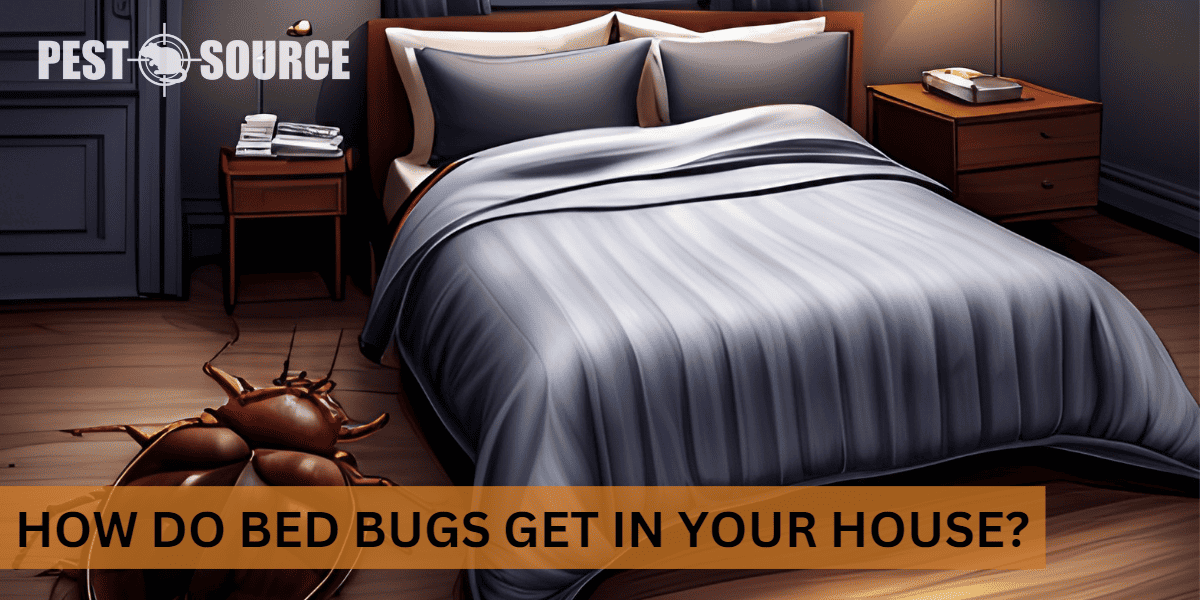Bed bugs can enter your house through luggage, clothing, used furniture, and other items that have been in infested areas. They can also travel between apartments or hotel rooms through wall voids, ductwork, and cracks in the building’s infrastructure. Learn more about the common entry points for bed bugs and preventive measures to keep them out of your home.
POINTS
- Bed bugs are expert hitchhikers that find their way into homes via luggage, clothing, furniture, and personal belongings, primarily via human activity like travel and commerce.
- These pests are attracted to carbon dioxide and body heat, feeding primarily on human blood, and can infest any place where they find these attractants, regardless of hygiene or cleanliness.
- Bed bugs infestations usually start in areas where people sleep or spend considerable amounts of time. Shared housing and apartments often facilitate their spread due to their proximity to multiple hosts and easy access to hiding spots.
- Prevention measures like decluttering, staying educated on the signs of infestations, seal cracks, using heat treatment for items and clothes, erecting barriers in your bed, and being vigilant when traveling or acquiring second-hand items are crucial for managing and avoiding an infestation.
- The main cause of bed bugs is human activities, thus, altering our behavior and staying cautious can aid in prevention. But remember, if an infestation occurs, reach out to professionals and reliable online resources to ensure thorough treatment and elimination.
Understanding the Nature of Bed Bugs
What are bed bugs and where do they originally come from?
Bed bugs, scientifically referred to as Cimex lectularius, are tiny, nocturnal parasites that traditionally inhibited caves, nesting alongside bats. With human settlement and development of caves, these bugs found a new host to feed upon, which is us, humans. Bed bugs have adopted a worldwide distribution, thanks to human travel and commerce.
What are the primary causes of bed bugs?
The primary cause of bed bugs is human activity, particularly those that involve frequent travel. Since these pests are stowaways, bed bugs effortlessly hitch a ride on luggage, clothing, furniture, and personal belongings of people who have been in an infested place. Poor sanitation does not directly lead to bed bugs as they solely depend on blood meals for survival and reproduction. Nevertheless, clutter can provide more hiding spots for these bugs, contributing indirectly to their infestations.
The Dynamics of Bed Bugs Infestation
How do bed bugs get into houses?
As mentioned earlier, bed bugs are exceptionally skilled hitchhikers. They get into houses often by clinging onto our luggage, furniture or clothing when we unknowingly come into contact with an infested environment. Remember, bed bugs don’t fly or jump, they primarily move by crawling, making our belongings an excellent transport medium.
How do bed bugs start in a location?
Bed bugs usually start in areas where people sleep or spend significant amounts of time. That’s why we often find them infesting bedrooms and living rooms first. The proximity to their host makes it easy for them to feed and reproduce, leading to quick, aggressive infestations.
What are the typical means through which people contract bed bugs?
The most common means to contract bed bugs include staying in infested accommodations, visiting infested homes or buildings, and bringing home used or rented furniture that’s already infested with bed bugs. Even shared laundry facilities can be a vector for bed bug transfer.
Why do bed bugs appear and what conditions facilitate their spread?
Bed bugs appear wherever they find accessible human blood and good hiding spots. Close-quarter living situations like apartments, dormitories, and shelters often magnify infestations due to easy movement between units or rooms. Furthermore, bed bugs breed explosively under favorable temperatures (70-80°F) which is common of indoor living conditions. Therefore, while you may observe “upsurges”, the truth is, bed bugs are continuously present, just often in varying degrees.
Unpacking the Attraction Mechanisms of Bed Bugs
What attracts bed bugs to human habitats?
Bed bugs are mainly attracted by two things – the carbon dioxide we exhale and our body heat. Their sharp survival instincts enable them to detect these hints from their hosts, even from a distance. As blood is their only food, any place where humans sit, rest, or sleep for extended periods can become a prime target for these tiny vampires.
Do certain scents or smells attract bed bugs?
Yes, certain scents do attract bed bugs. They respond to the smell of a sleeping host’s breath and are lured by the warmth and carbon dioxide exhaled in the air. Also, research shows that these bugs are not attracted to dirty environments per se, but are drawn more to the scent of humans, irrespective of hygiene status.
Are bed bugs attracted to food?
Unlike many pests, bed bugs are not attracted to scraps of food. They are obligate hematophagous, meaning their diet solely comprises of blood – preferably human. This dietary constraint means that general domestic cleanliness bears little influence on deterring or encouraging bedbugs.
Are bed bugs attracted to certain personal products, such as perfume?
Currently, there’s no definitive body of research to suggest that bed bugs are attracted or repelled by certain personal products like perfumes. These bugs are more focused on carbon dioxide and warmth, the key signals that a meal is nearby.
Are bed bugs attracted to period blood?
This is a common myth that needs correction. Bed bugs are not attracted to period blood. Their attraction is towards the body heat and the carbon dioxide we exhale, not to blood out in the open. Thus, menstrual blood does not increase your risk of attracting bed bugs.
How do bed bugs hide and where do they commonly take refuge?
Bed bugs are masters of concealment. During the day, they squeeze themselves into cozy, dark crevices in your mattress, bed frames, headboards, box springs, furniture, and even behind wallpaper or under carpeting. Basically, they hide anywhere within 5-20 feet of where people sleep or sit, ready to venture out for their night-time blood meal.
What specific things bring bed bugs out of hiding?
Bed bugs usually come out of hiding in the dark, preferring to feed when humans are asleep. Their habits are generally nocturnal and their prime feeding time is between midnight and 5 a.m. Any hint of human presence such as the heat and carbon dioxide released when people are in deep sleep, bring them out of their hiding spots.
Understanding Personal Risks and Exposure to Bed Bugs
How does one get bed bugs?
Anyone can get bed bugs, and getting them is often a matter of bad luck. You may acquire bed bugs from a hotel room, a friend’s house, or even a public transport seat. They sneak into your stuff and travel home with you. Remember, bed bugs are not a sign of a dirty home or poor hygiene; they are simply attracted to humans because humans are their food source.
How did I get bed bugs in my home?
If you’re wondering how you got bed bugs in your home, consider your recent activities. Have you traveled recently? Did you acquire used furniture or other second-hand items? Have you had guests over? Answering these questions might provide insight into how these pests made their way into your home.
How does someone get bed bugs in their beds?
Bed bugs are proficient travelers. They can easily latch themselves to luggage, clothing, and even used furniture to reach your home. If you unknowingly slept in an infested place or brought infested stuff into your home, there’s a high chance that you might end up with bed bugs in your bed.
What are common practices that lead to bed bug infestations?
There are several everyday practices that can lead to bed bug infestations at home. These include:
- Not inspecting hotel rooms or vacation rentals for signs of bed bugs.
- Buying and bringing used furniture home without checking for bed bugs.
- Not taking necessary precautions with luggage during travel.
- Ignoring early signs of bed bugs, allowing them to breed and spread.
How can sharing clothes or moving infested furniture lead to a bed bug infestation?
Bed bugs can survive for months without feeding, allowing them to stay hidden in clothes or furniture. If you share infested clothing or move infested furniture into your home, you’re potentially moving bed bugs in as well.
How do travel habits contribute to the risk of getting bed bugs?
Bed bugs are common in places with high turnover rates, such as hotels or hostels. If you stay in these places and do not inspect or take precautions with your luggage, it’s easy to inadvertently take some bugs home with you. Travel has been a significant factor in the resurgence and spread of bed bugs in recent years.
Prevention and Mitigation Strategies
What to do if you suspect bed bugs have entered your home?
If you suspect bed bugs have entered your home, the first step is to confirm their presence. Look for live bugs and signs of them such as small blood stains, bed bug excrement, and eggshells on your sheets or mattress.
Once confirmed, you should:
- Clean up clutter around your home
- Seal any cracks where bed bugs could potentially hide
- Heat-treat your clothing and bedding by washing at high temperatures
- Vacuum your home thoroughly, paying particular attention to your sleeping areas
- If the infestation is serious, consider seeking professional pest control services
Remember, acting swiftly is key to preventing a full-blown infestation.
How do you prevent bed bugs from coming out of hiding and spreading?
Since bed bugs usually come out at night to feed, you might consider using some form of bed bug interceptor at the legs of your bed. This would prevent them from reaching you while you sleep thereby interrupting their feeding and reproduction.
You might also consider using mattress encasements which can trap bugs already inside and prevent new ones from finding hiding spots in your bed. Regularly vacuuming your bedding and around your bed can also help significantly reduce their numbers.
What steps can be taken to prevent getting bed bugs from travel or through shared items?
When traveling or sharing items:
- Inspect your hotel room or borrowed item for signs of an infestation prior to use.
- Keep luggage off the floor and bed in hotel rooms.
- Regularly clean shared items like school books or uniforms, ideally heat-treating them.
- After travel, immediately wash all clothing and inspect your luggage before bringing it in your home.
How can one protect their home and bed from a potential bed bug infestation?
Preventing a bed bug infestation can be accomplished in a number of ways:
- Regularly inspect your home, particularly around sleeping areas.
- Use protective covers over mattresses and box springs.
- Declutter your home, reducing potential hiding spots.
- Avoid bringing second-hand furniture into your home, unless you’ve thoroughly inspected and cleaned it beforehand.
- Educate yourself and your family about the signs of a bed bug infestation.
By following these steps, you can reduce your risk of a bed bug infestation.



